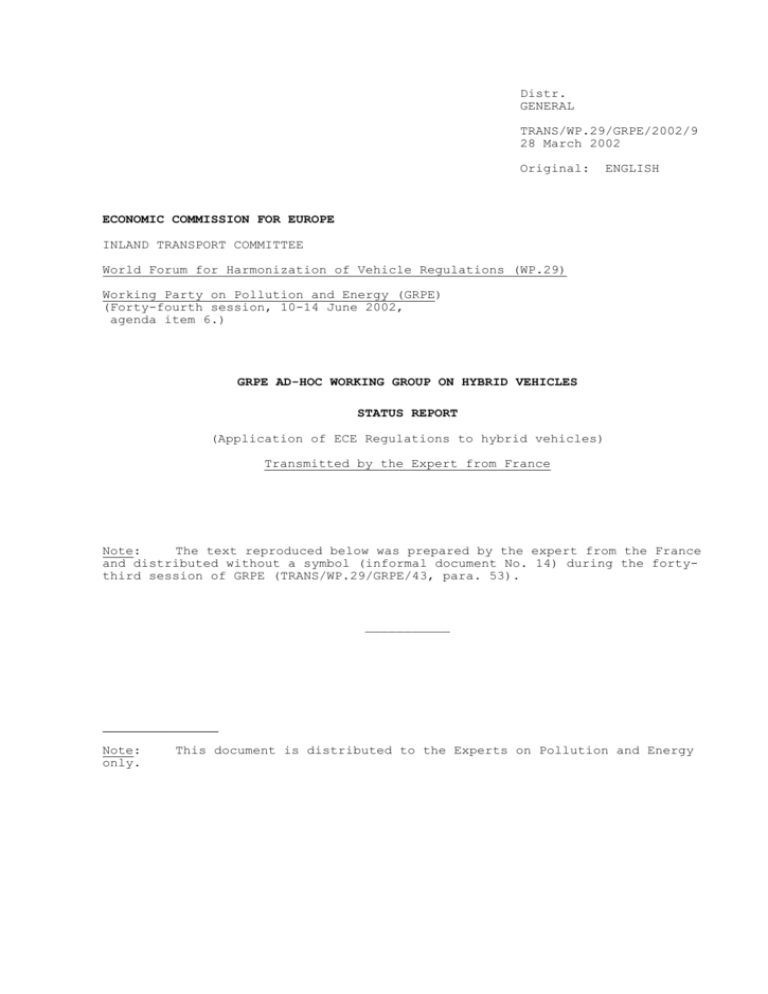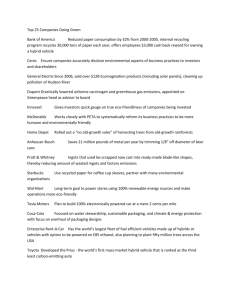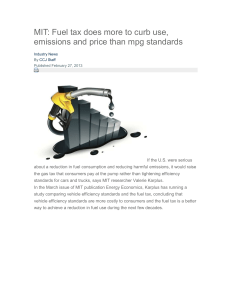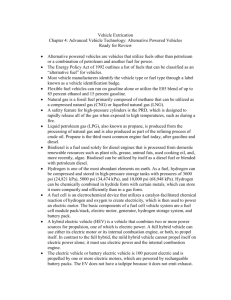Distr - unece
advertisement

Distr. GENERAL TRANS/WP.29/GRPE/2002/9 28 March 2002 Original: ENGLISH ECONOMIC COMMISSION FOR EUROPE INLAND TRANSPORT COMMITTEE World Forum for Harmonization of Vehicle Regulations (WP.29) Working Party on Pollution and Energy (GRPE) (Forty-fourth session, 10-14 June 2002, agenda item 6.) GRPE AD-HOC WORKING GROUP ON HYBRID VEHICLES STATUS REPORT (Application of ECE Regulations to hybrid vehicles) Transmitted by the Expert from France Note: The text reproduced below was prepared by the expert from the France and distributed without a symbol (informal document No. 14) during the fortythird session of GRPE (TRANS/WP.29/GRPE/43, para. 53). ___________ _______________ Note: only. This document is distributed to the Experts on Pollution and Energy TRANS/WP.29/GRPE/2002/9 page 2 At its forty-second session GRPE approved the setting-up of a working group on hybrid vehicles and adopted its mandate. This group including experts from Germany, Netherlands, Japan, Sweden, Italy, United-Kingdom, OICA and France met twice to work on: 1. 2. 3. 4. Definitions Categories of hybrid electric vehicles (HEV) Regulations to be amended in priority Principles of test methods for emissions and fuel consumption measurements The group’s approach is to be pragmatic in order to propose quickly amendments to existing regulations for homologation of hybrid vehicles coming into the market very soon (mandate from GRPE). In addition the Dutch delegation proposes a parallel activity to produce a document that describes and analyses fundamental problems that cannot be dealt with adequately within the context presented by the mandate of the GRPE-HEV working group. It was decided by the group that this new activity should be decided by GRPE, because not in the initial mandate. This report gives progress on the work undergoing in the GRPE ad-hoc group. The future regulation amendments for introduction of hybrid vehicles will be based on the definitions and the test principles mentioned hereafter and agreed by the group, bearing in mind that some items are still under consideration and that parts of the text are in square brackets because still under discussion. 1. DEFINITIONS 1.1. General definition of hybrid vehicles (HV): A hybrid vehicle (HV) means a vehicle with at least two different energy converters and two different energy storage systems (on vehicle) for the purpose of vehicle propulsion. 1.2. Definition of hybrid electric vehicles (HEV): A hybrid electric vehicle (HEV) means a vehicle that can draw mechanical propulsion energy from both of the following on-vehicle sources of stored energy/power: 1.2.1. a consumable fuel 1.2.2. an electrical energy/power storage device (e.g.: battery, capacitor, flywheel …) 2. CATEGORIES OF HEV (including driver’s selectable modes) Vehicle charging Operating mode switch (a) (b) Off-Vehicle Charging (a) Not Off-Vehicle Charging (b) (OVC) (NOVC) With Without With also known as "externally chargeable" also known as "not externally chargeable" Without TRANS/WP.29/GRPE/2002/9 page 3 3. PRIORITY SEQUENCE IN ECE REGULATIONS REVISIONS It was decided to give high priority in the revisions of Regulation No. 83, Regulation No. 101 and Regulation No. 85. 4. TEST METHODS FOR EMISSIONS AND FUEL CONSUMPTION MEASUREMENTS As a general principle, for the following test procedures, the HEV will be tested under the most favourable conditions and the worstcase conditions. For emissions, the test results must comply with the limits under the two test conditions. For CO2/energy consumption, the average of the two test results will be considered. 4.1. Externally chargeable (OVC HEV) without an operating mode switch 4.1.1. Emission tests Two tests are performed under the following conditions: Test 1: Type I test has to be carried out with a fully charged 1/ electrical energy/power storage device. Test 2: Type I test has to be carried out with an electrical energy/power storage 2/ device in minimum state of charge (maximum discharge of capacity). In test 1 and test 2, mass emissions of each pollutant (HC, CO, NOx and PM, if required) in g/km have to meet the emission limits. Final test result (for communication): mean value of Test 1 and Test 2 4.1.2. CO2 / energy consumption Test 1: - same as for emissions - charge of the battery according Regulation No. 101 with measurement of energy: E1 - discharge of the battery down to minimum state of charge 2/ Test 2: - same as for emissions - charge of the battery according Regulation No. 101 with measurement of energy: E2 - discharge of the battery down to minimum state of 1/ If the manufacturer delivers no recommendations about charging of the battery for HEV which are externally chargeable, the procedures described in Regulation No. 101, Annex 6 paragraph 2.4.1.2. are applied. 2/ Definition of minimum state of charge of the electrical energy/power storage device: During preconditioning the consumable fuel power unit of the HEV must start up at least once when discharging at constant speed of [40 km/h] or with manufacturer’s recommendation. TRANS/WP.29/GRPE/2002/9 page 4 charge 2/ - charge of the battery according Regulation No. 101 with measurement of energy: E3 TRANS/WP.29/GRPE/2002/9 page 5 Final test results (for communication): CO2 (g/km): mean value of Test 1 and Test 2 on complete cycle (urban + extra-urban). Energy consumption: fuel consumption (l/100 km): average value of Test 1 and Test 2 electric consumption (Wh/km): E1 + (E2-E3) total distance during Test 1 and Test 2 As an option, manufacturer may request an extra test on urban cycle only following the complete procedure above-mentioned 4.2. Externally chargeable (OVC HEV) with an operating mode switch 4.2.1. Emission tests Two tests are performed under the same conditions as in 4.1.1. The emission limits must be achieved both in Test 1 and Test 2, according to the following table: OVC HEV with an operating mode switch: measurement of emissions Hybrid-modes Battery state of charge Test No. 1 Fully charged Test No. 2 Min. state of charge - Pure electric - Hybrid - Pure fuel consuming - Hybrid - Pure electric - Pure fuel consuming - Hybrid - Hybrid mode n */ - Hybrid mode m */ Switch in position Switch in position Switch in position Switch in position Hybrid Hybrid Hybrid Most electric hybrid mode Hybrid Fuel consuming Fuel consuming Most fuel consuming mode */ for e.g.: sport, economic, urban, extra-urban position, … Tests results are calculated as in 4.1.1. 4.2.2. CO2/energy consumption Two tests are performed under same conditions as in 4.1.1. Both electric energy and fuel consumption and CO2 emissions must be reported for each test. Depending on the different operating modes this procedure has to be carried out for each switch position, according to the following table: TRANS/WP.29/GRPE/2002/9 page 6 OVC HEV with an operating mode switch: measurement of CO2/energy consumption Hybrid-modes - Pure electric - Hybrid - Pure fuel consuming - Hybrid (c) Battery state of charge Test n° 1: Fully charged (a) (b) (c) - Hybrid mode n - Hybrid mode m Switch in position Switch in position Switch in position Switch in position Electric (a) Hybrid Electric (a) Most electric hybrid mode l/100 km and Wh/km Wh/km l/100 km and Wh/km Fuel consuming Fuel consuming l/100 km l/100 km Wh/km Test n° 2: Min. state of charge - Pure electric - Pure fuel consuming - Hybrid Hybrid (b) Wh/km and l/100 km Most fuel consuming mode l/100 km and Wh/km If the vehicle range on electric mode is lower than one complete cycle, the test is carried out on hybrid mode only. Same test procedure as in 4.1.2. Case of an electric vehicle with a range extender: considered as an OVC vehicle with an operating mode switch, having an extended range of [a maximum of 25 per cent or/and a limited fuel tank capacity of 15 l]. For these vehicles (almost electric vehicles), the tests are carried out according to the first column of the table above but for CO2 emissions and energy consumption calculation purposes, an annual average coefficient in service of [X %] may be used. Test results reporting to be specified later on. 4.3. Not externally chargeable (not OVC HEV) without an operating mode switch. 4.3.1. Emission tests For NOVC vehicles two types need to be distinguished: vehicles with a negligible SOC over a type I test vehicles with a non-negligible SOC over a type I test SOC: net change in electrical energy over duration of test cycle. If it can be demonstrated for a vehicle that the condition: Ebatt / Econsumed 4 fuel Ah Vbatt / Econsumed fuel n %, with e.g. n = 2 - is always fulfilled over a type I test, then the vehicle’s SOC can be considered to have a negligible influence on the measured pollutant emissions (as well as on fuel consumption and CO2-emission). For such a vehicle only one type I test (including preconditioning, soak and measurement) is performed to measure TRANS/WP.29/GRPE/2002/9 page 7 emissions. TRANS/WP.29/GRPE/2002/9 page 8 For vehicles that do not fulfil the above-mentioned condition some form of SOC-correction method is required to perform a meaningful measurement of pollutant emissions, fuel consumption and CO2-emission. A possibility I tests until then take the must meet the proposed for these type of vehicles is to perform type the previous condition is fulfilled (up to 3 tests) and mean emissions of the number of tests performed that emissions standards. For the next meeting the Dutch delegation will prepare a document with a description and analysis of the different available options for SOC-correction, taking into account the Japanese, German and French views on this issue as expressed in previous documents submitted to the working group. This document will use information obtained from international literature, the MATADOR-project and other previous projects. 4.3.2. CO2 / energy consumption If it can be demonstrated for a vehicle that the condition: Ebatt / Econsumed 4 fuel Ah Vbatt / Econsumed fuel n %, with e.g. n = 2 - is always fulfilled over a type I test, then the vehicle’s SOC can be considered to have a negligible influence on the measured fuel consumption and CO2-emission. For such a vehicle only one type I test (including preconditioning, soak and measurement) is performed to measure fuel consumption and CO2-emission. For vehicles that do not fulfil the above-mentioned condition some form of SOC-correction method is required to perform a meaningful measurement of pollutant emissions, fuel consumption and CO2-emission. A possibility proposed for this type of vehicles is to perform type I tests until the previous condition is fulfilled (up to 3 tests) and then use the mean value of the number of tests performed. 4.4. Not externally chargeable (Not OVC HEV) with an operating mode switch Still under discussion. 5. NEXT MEETING: 12 March 2002 in Paris. ______________




